Case Study: Amy's Alzheimer's Disease - Diagnosis, Treatment, and Care
VerifiedAdded on 2021/06/17
|12
|957
|68
Case Study
AI Summary
This case study presents the case of Amy, a 59-year-old woman diagnosed with Alzheimer's disease. The assignment provides a general overview of Alzheimer's, its prevalence, genetic factors, and common symptoms, particularly in geriatric patients. Amy's patient information, including her history of smoking, angina, and pollen allergy, is detailed, along with her medication and the need for palliative care due to language comprehension difficulties and reduced mobility. The importance of maintaining the patient's quality of life through physical, mental, and emotional support is emphasized. The case study also references several research papers and studies related to Alzheimer's disease, including those on biomarkers, genetic susceptibility, and the impact of exercise on cognition and quality of life.
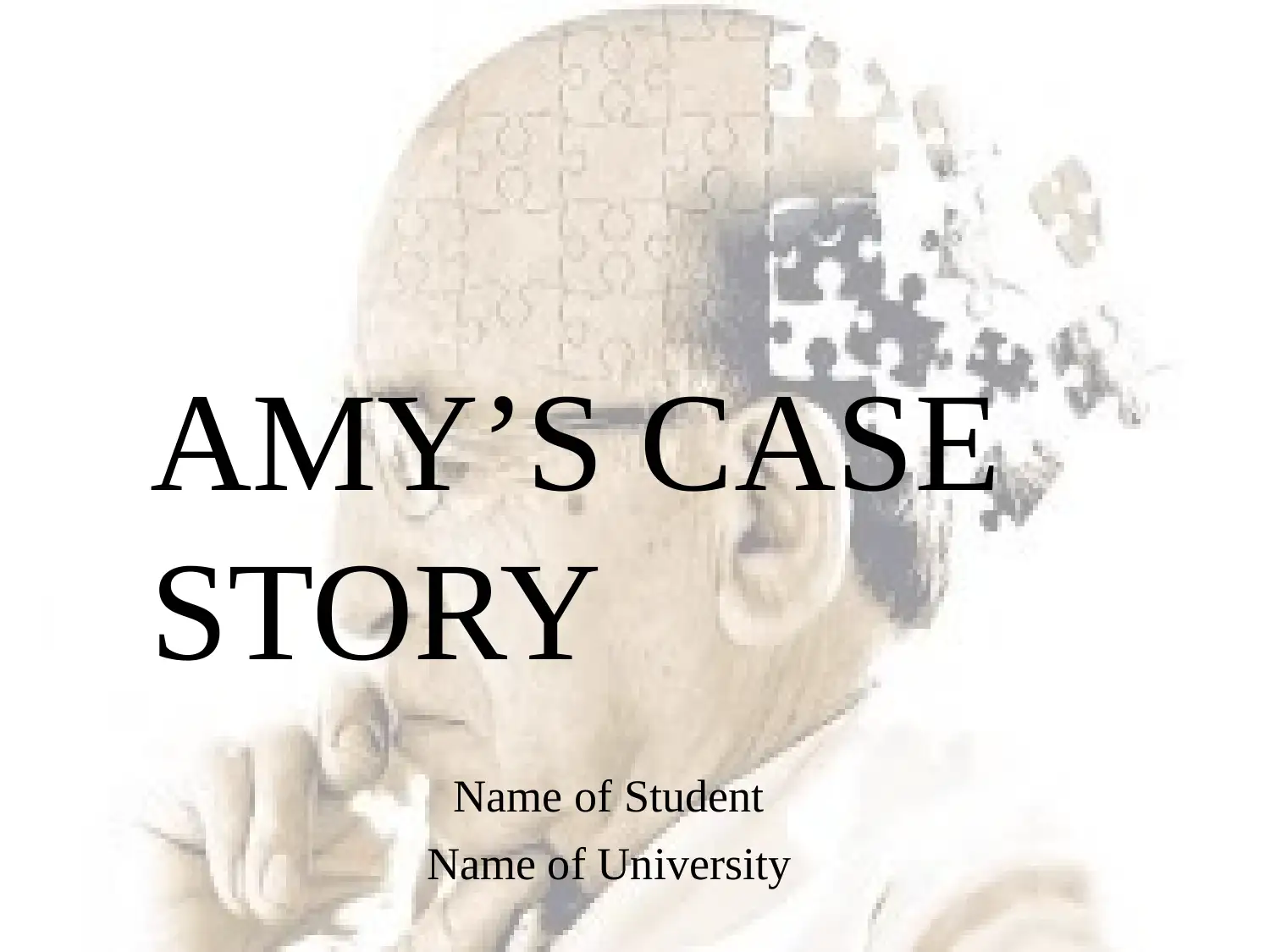
AMY’S CASE
STORY
Name of Student
Name of University
STORY
Name of Student
Name of University
Paraphrase This Document
Need a fresh take? Get an instant paraphrase of this document with our AI Paraphraser
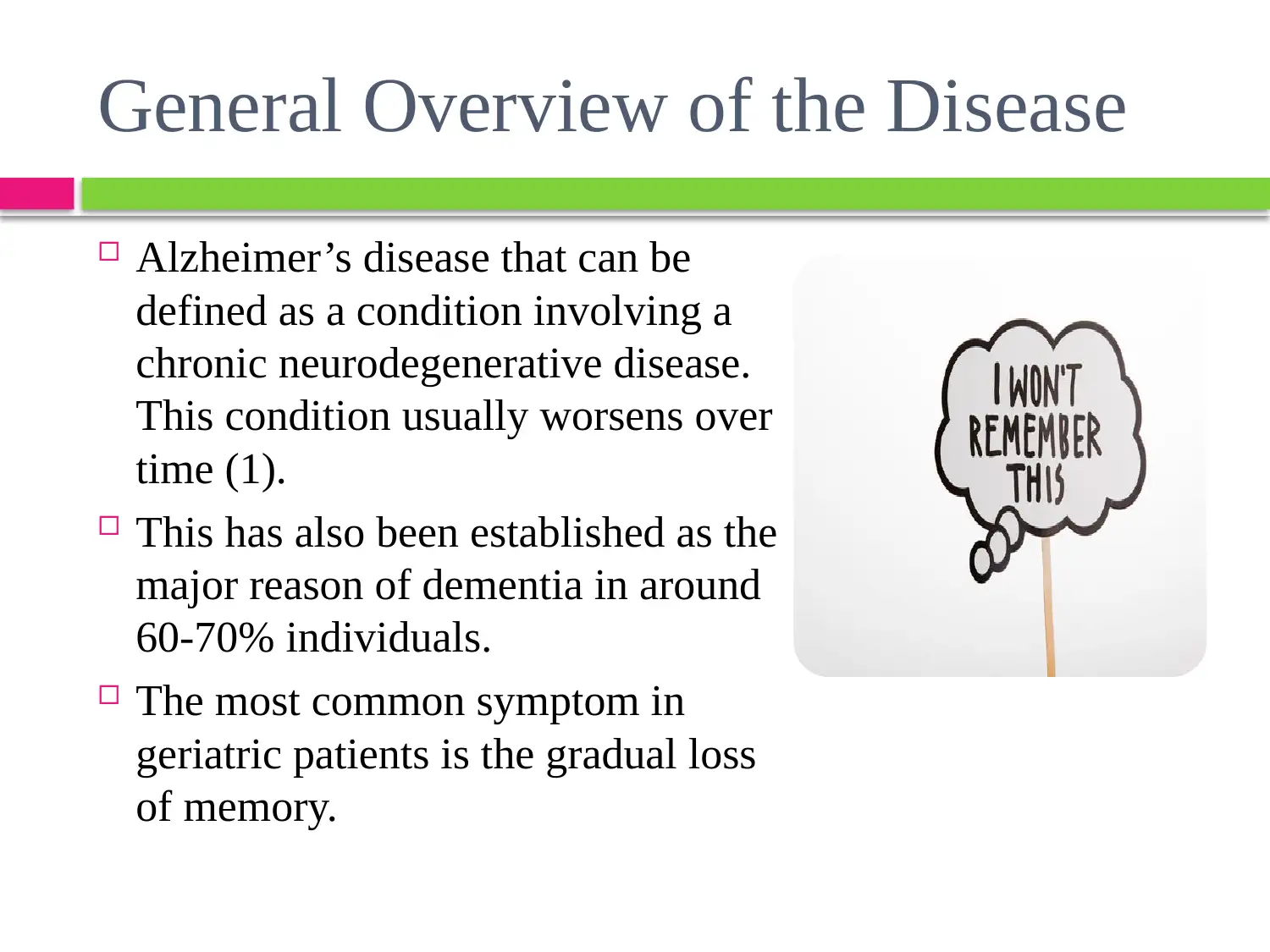
General Overview of the Disease
Alzheimer’s disease that can be
defined as a condition involving a
chronic neurodegenerative disease.
This condition usually worsens over
time (1).
This has also been established as the
major reason of dementia in around
60-70% individuals.
The most common symptom in
geriatric patients is the gradual loss
of memory.
Alzheimer’s disease that can be
defined as a condition involving a
chronic neurodegenerative disease.
This condition usually worsens over
time (1).
This has also been established as the
major reason of dementia in around
60-70% individuals.
The most common symptom in
geriatric patients is the gradual loss
of memory.
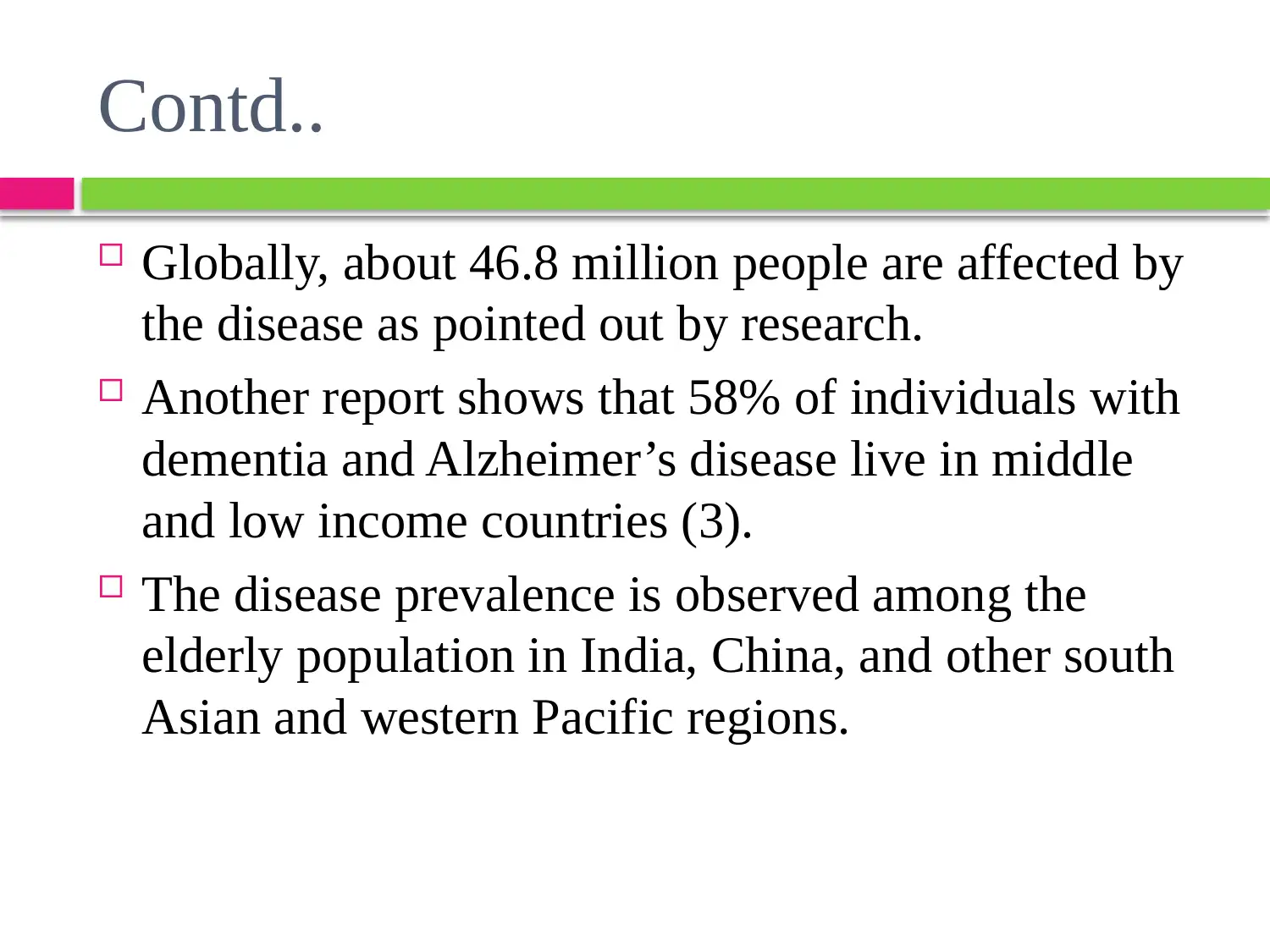
Contd..
Globally, about 46.8 million people are affected by
the disease as pointed out by research.
Another report shows that 58% of individuals with
dementia and Alzheimer’s disease live in middle
and low income countries (3).
The disease prevalence is observed among the
elderly population in India, China, and other south
Asian and western Pacific regions.
Globally, about 46.8 million people are affected by
the disease as pointed out by research.
Another report shows that 58% of individuals with
dementia and Alzheimer’s disease live in middle
and low income countries (3).
The disease prevalence is observed among the
elderly population in India, China, and other south
Asian and western Pacific regions.
⊘ This is a preview!⊘
Do you want full access?
Subscribe today to unlock all pages.

Trusted by 1+ million students worldwide
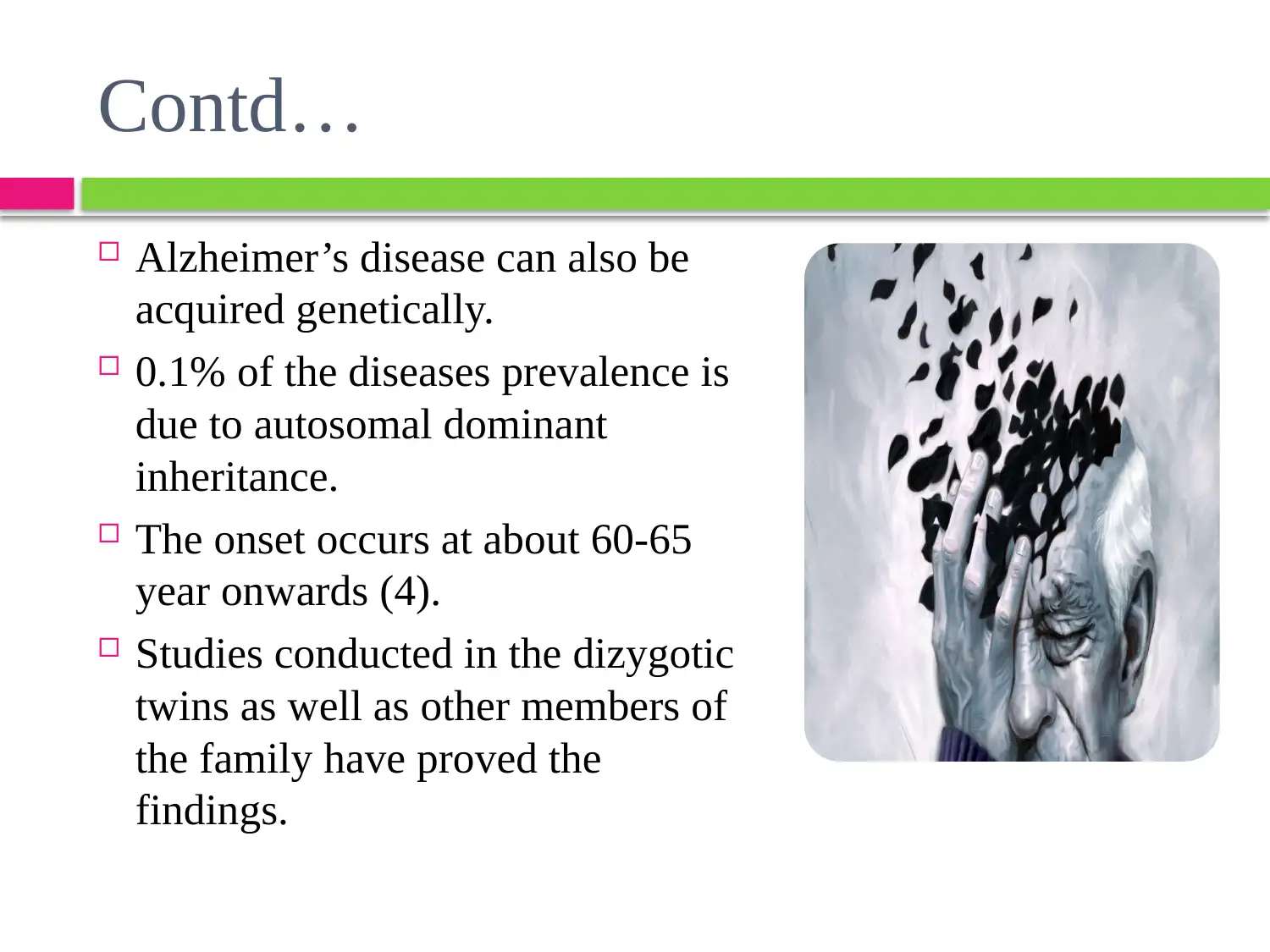
Contd…
Alzheimer’s disease can also be
acquired genetically.
0.1% of the diseases prevalence is
due to autosomal dominant
inheritance.
The onset occurs at about 60-65
year onwards (4).
Studies conducted in the dizygotic
twins as well as other members of
the family have proved the
findings.
Alzheimer’s disease can also be
acquired genetically.
0.1% of the diseases prevalence is
due to autosomal dominant
inheritance.
The onset occurs at about 60-65
year onwards (4).
Studies conducted in the dizygotic
twins as well as other members of
the family have proved the
findings.
Paraphrase This Document
Need a fresh take? Get an instant paraphrase of this document with our AI Paraphraser
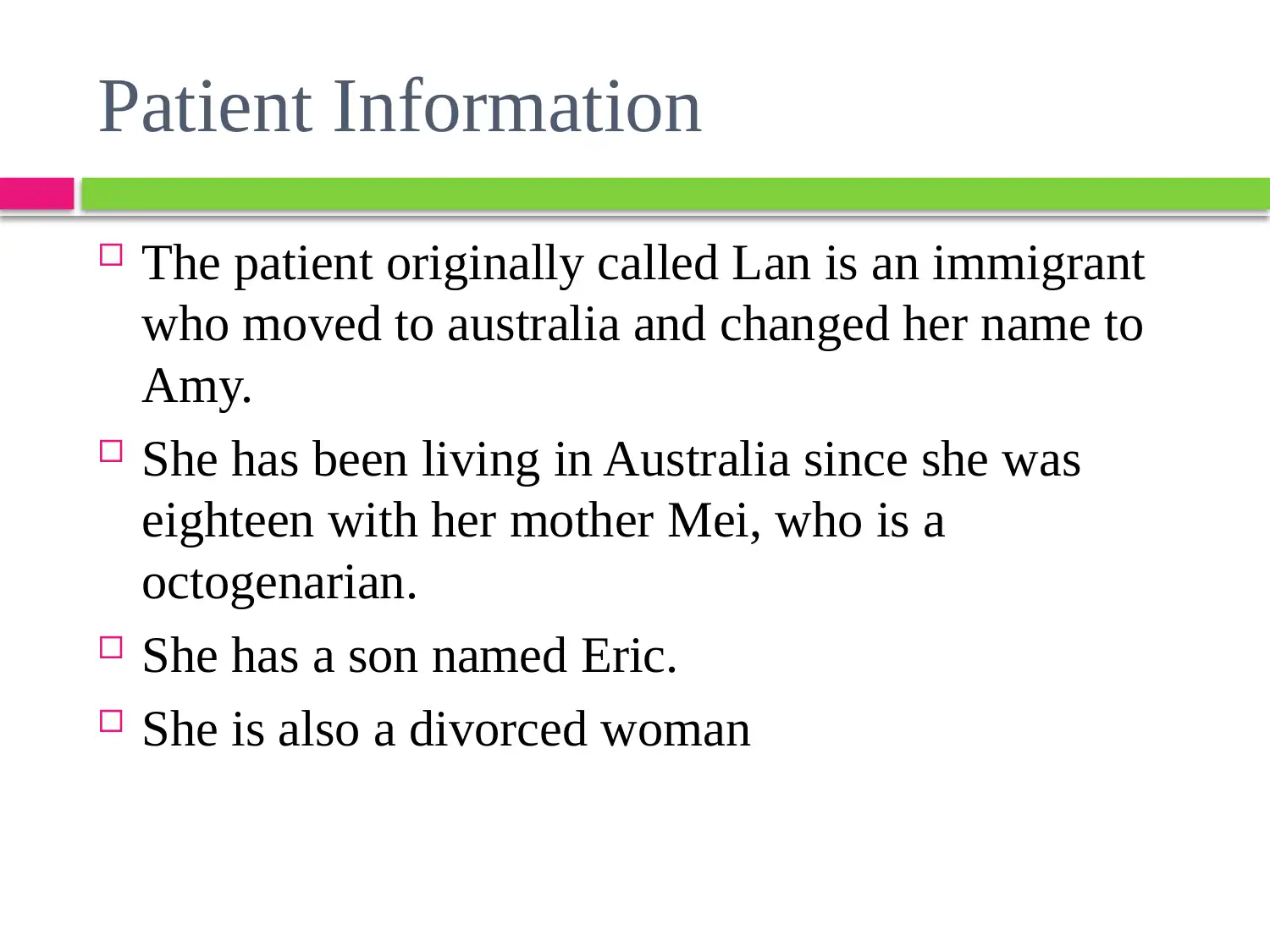
Patient Information
The patient originally called Lan is an immigrant
who moved to australia and changed her name to
Amy.
She has been living in Australia since she was
eighteen with her mother Mei, who is a
octogenarian.
She has a son named Eric.
She is also a divorced woman
The patient originally called Lan is an immigrant
who moved to australia and changed her name to
Amy.
She has been living in Australia since she was
eighteen with her mother Mei, who is a
octogenarian.
She has a son named Eric.
She is also a divorced woman
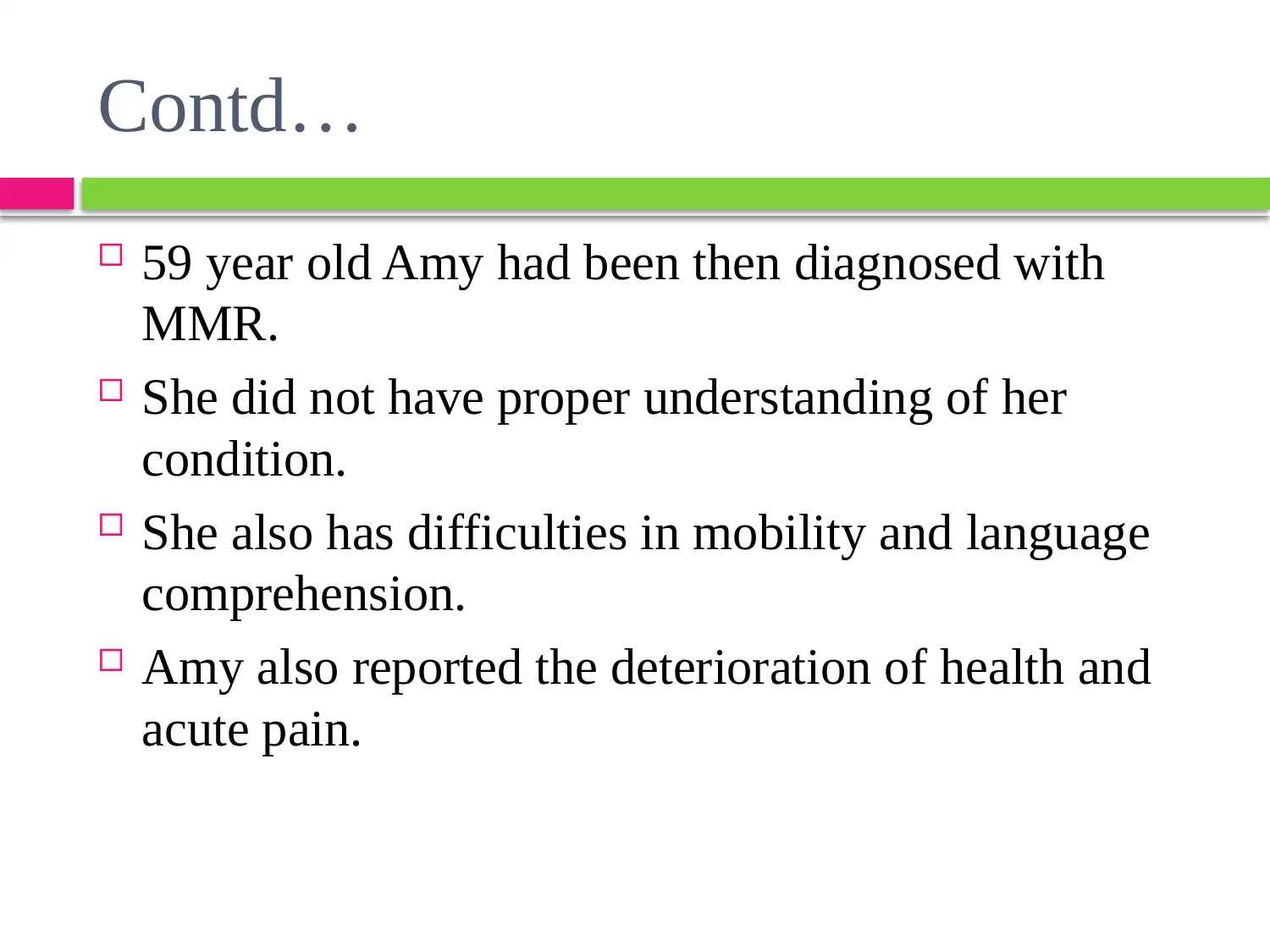
Contd…
59 year old Amy had been then diagnosed with
MMR.
She did not have proper understanding of her
condition.
She also has difficulties in mobility and language
comprehension.
Amy also reported the deterioration of health and
acute pain.
59 year old Amy had been then diagnosed with
MMR.
She did not have proper understanding of her
condition.
She also has difficulties in mobility and language
comprehension.
Amy also reported the deterioration of health and
acute pain.
⊘ This is a preview!⊘
Do you want full access?
Subscribe today to unlock all pages.

Trusted by 1+ million students worldwide
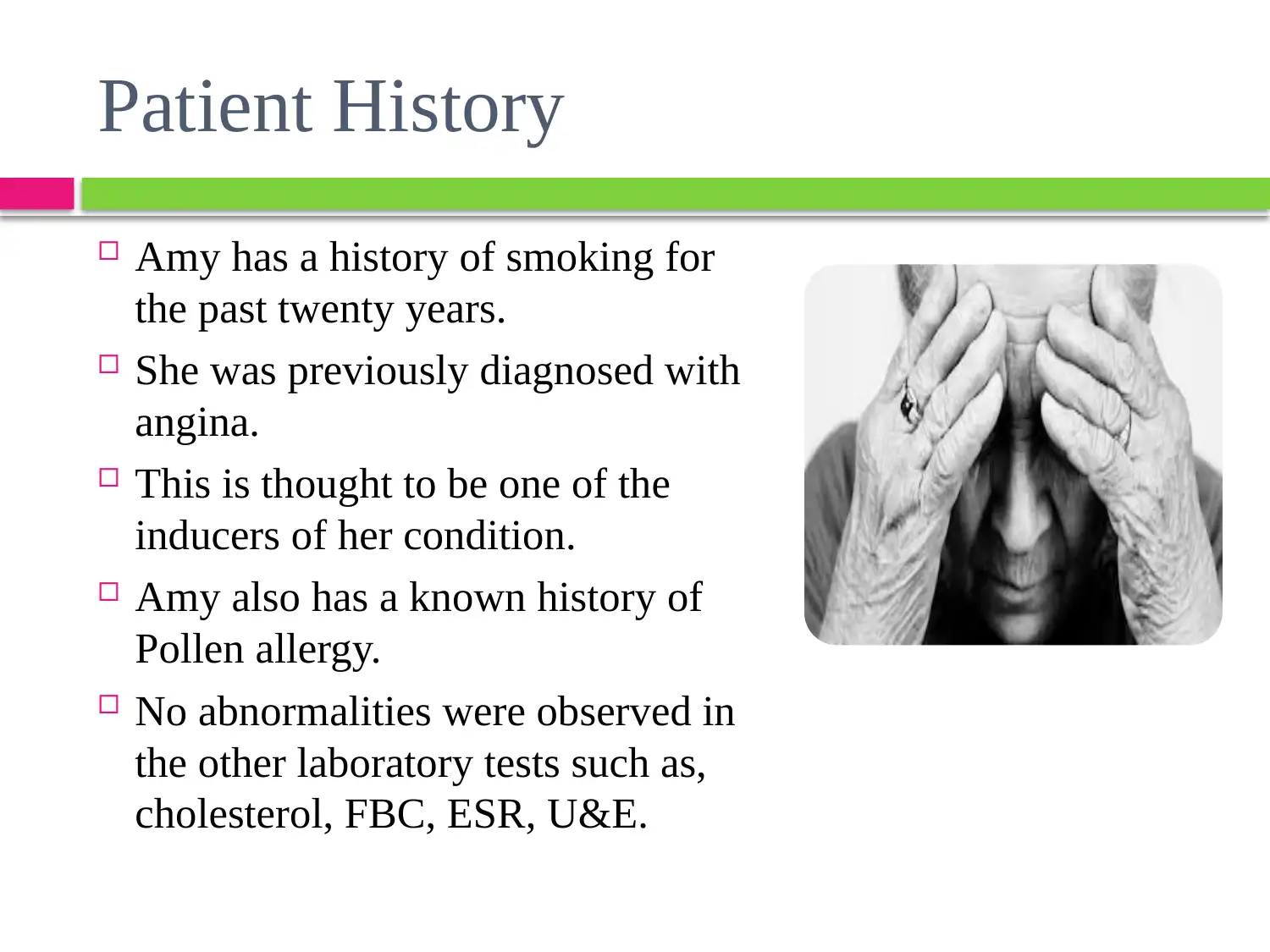
Patient History
Amy has a history of smoking for
the past twenty years.
She was previously diagnosed with
angina.
This is thought to be one of the
inducers of her condition.
Amy also has a known history of
Pollen allergy.
No abnormalities were observed in
the other laboratory tests such as,
cholesterol, FBC, ESR, U&E.
Amy has a history of smoking for
the past twenty years.
She was previously diagnosed with
angina.
This is thought to be one of the
inducers of her condition.
Amy also has a known history of
Pollen allergy.
No abnormalities were observed in
the other laboratory tests such as,
cholesterol, FBC, ESR, U&E.
Paraphrase This Document
Need a fresh take? Get an instant paraphrase of this document with our AI Paraphraser
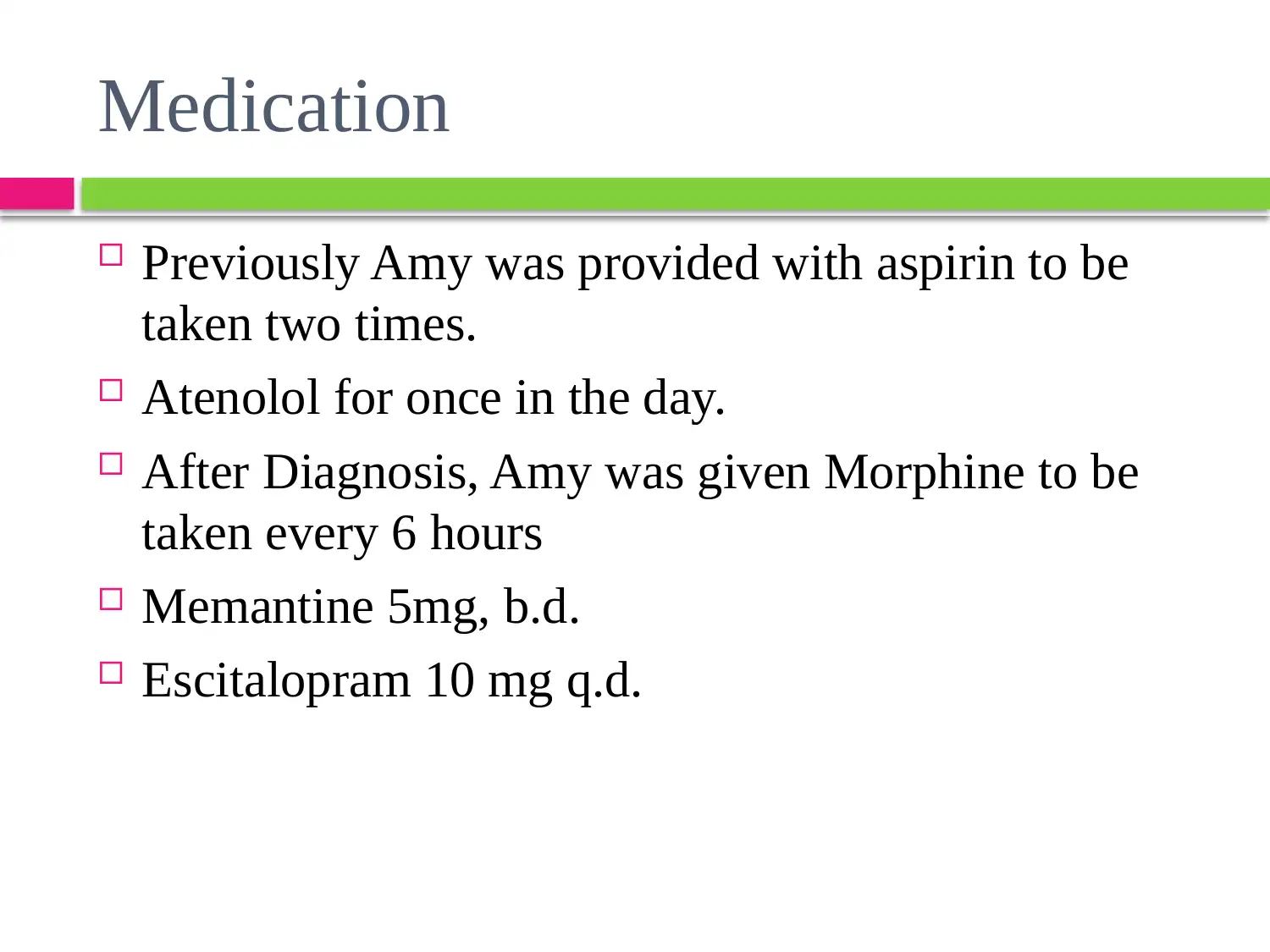
Medication
Previously Amy was provided with aspirin to be
taken two times.
Atenolol for once in the day.
After Diagnosis, Amy was given Morphine to be
taken every 6 hours
Memantine 5mg, b.d.
Escitalopram 10 mg q.d.
Previously Amy was provided with aspirin to be
taken two times.
Atenolol for once in the day.
After Diagnosis, Amy was given Morphine to be
taken every 6 hours
Memantine 5mg, b.d.
Escitalopram 10 mg q.d.
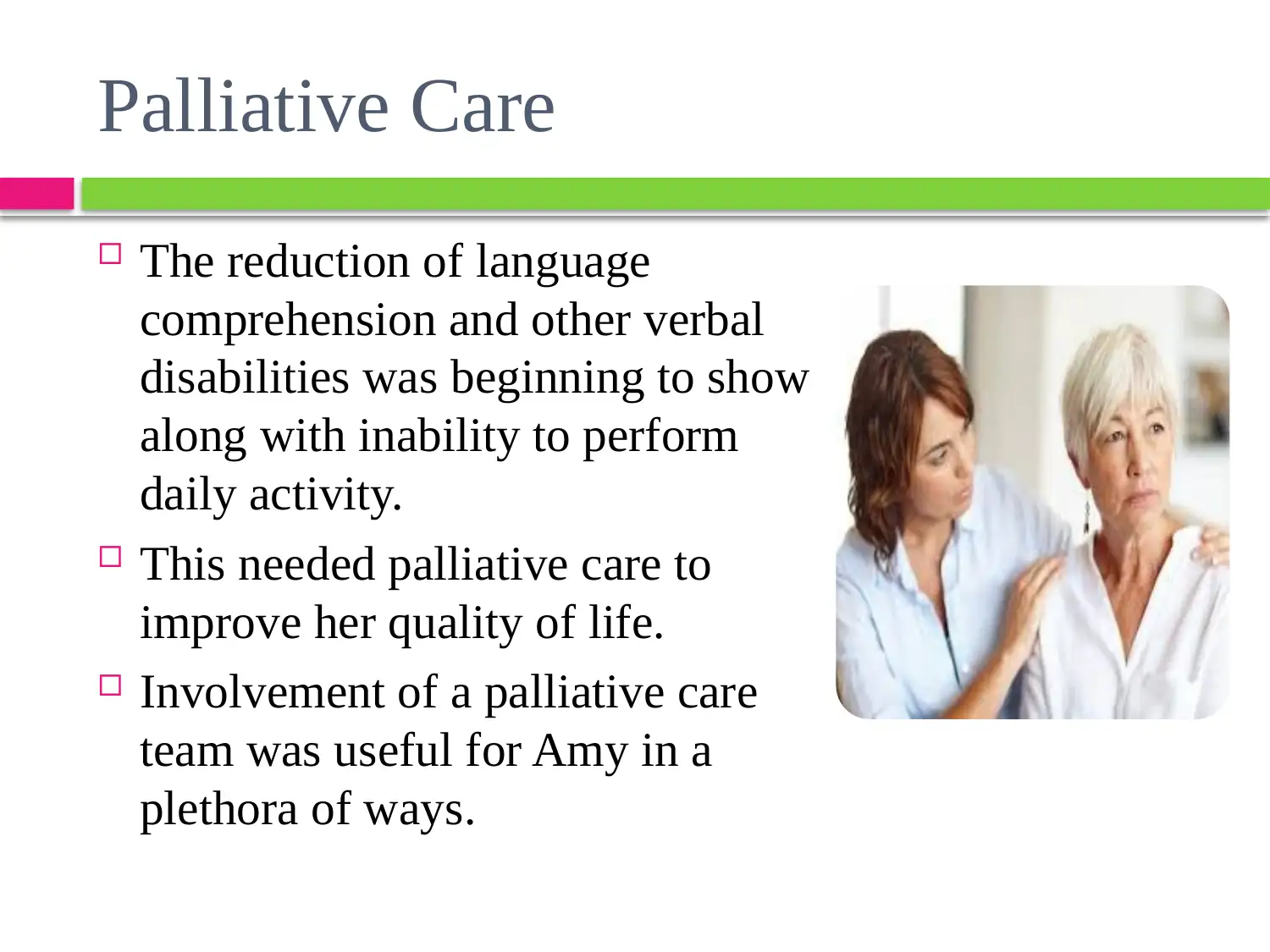
Palliative Care
The reduction of language
comprehension and other verbal
disabilities was beginning to show
along with inability to perform
daily activity.
This needed palliative care to
improve her quality of life.
Involvement of a palliative care
team was useful for Amy in a
plethora of ways.
The reduction of language
comprehension and other verbal
disabilities was beginning to show
along with inability to perform
daily activity.
This needed palliative care to
improve her quality of life.
Involvement of a palliative care
team was useful for Amy in a
plethora of ways.
⊘ This is a preview!⊘
Do you want full access?
Subscribe today to unlock all pages.

Trusted by 1+ million students worldwide
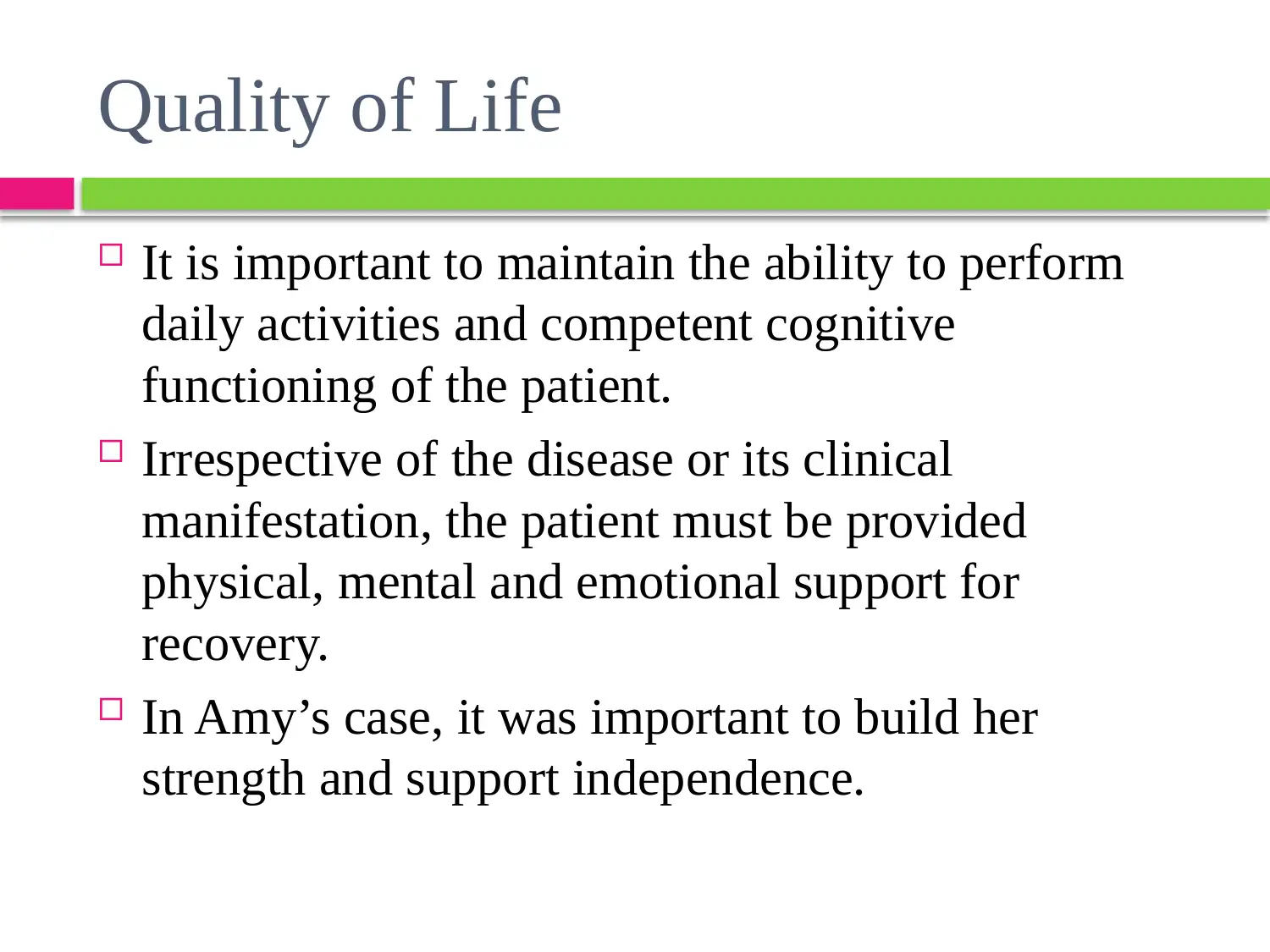
Quality of Life
It is important to maintain the ability to perform
daily activities and competent cognitive
functioning of the patient.
Irrespective of the disease or its clinical
manifestation, the patient must be provided
physical, mental and emotional support for
recovery.
In Amy’s case, it was important to build her
strength and support independence.
It is important to maintain the ability to perform
daily activities and competent cognitive
functioning of the patient.
Irrespective of the disease or its clinical
manifestation, the patient must be provided
physical, mental and emotional support for
recovery.
In Amy’s case, it was important to build her
strength and support independence.
Paraphrase This Document
Need a fresh take? Get an instant paraphrase of this document with our AI Paraphraser
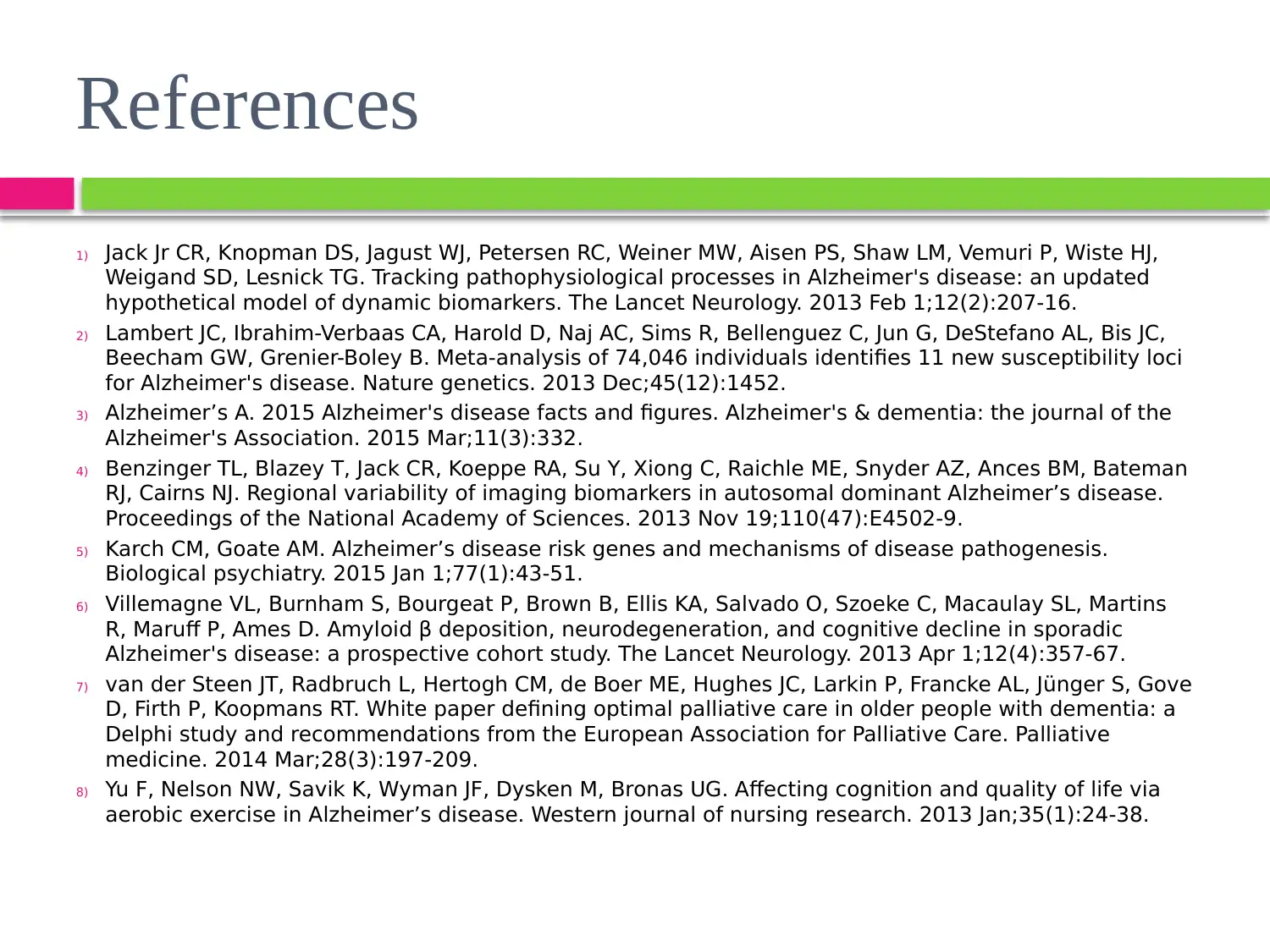
References
1) Jack Jr CR, Knopman DS, Jagust WJ, Petersen RC, Weiner MW, Aisen PS, Shaw LM, Vemuri P, Wiste HJ,
Weigand SD, Lesnick TG. Tracking pathophysiological processes in Alzheimer's disease: an updated
hypothetical model of dynamic biomarkers. The Lancet Neurology. 2013 Feb 1;12(2):207-16.
2) Lambert JC, Ibrahim-Verbaas CA, Harold D, Naj AC, Sims R, Bellenguez C, Jun G, DeStefano AL, Bis JC,
Beecham GW, Grenier-Boley B. Meta-analysis of 74,046 individuals identifies 11 new susceptibility loci
for Alzheimer's disease. Nature genetics. 2013 Dec;45(12):1452.
3) Alzheimer’s A. 2015 Alzheimer's disease facts and figures. Alzheimer's & dementia: the journal of the
Alzheimer's Association. 2015 Mar;11(3):332.
4) Benzinger TL, Blazey T, Jack CR, Koeppe RA, Su Y, Xiong C, Raichle ME, Snyder AZ, Ances BM, Bateman
RJ, Cairns NJ. Regional variability of imaging biomarkers in autosomal dominant Alzheimer’s disease.
Proceedings of the National Academy of Sciences. 2013 Nov 19;110(47):E4502-9.
5) Karch CM, Goate AM. Alzheimer’s disease risk genes and mechanisms of disease pathogenesis.
Biological psychiatry. 2015 Jan 1;77(1):43-51.
6) Villemagne VL, Burnham S, Bourgeat P, Brown B, Ellis KA, Salvado O, Szoeke C, Macaulay SL, Martins
R, Maruff P, Ames D. Amyloid β deposition, neurodegeneration, and cognitive decline in sporadic
Alzheimer's disease: a prospective cohort study. The Lancet Neurology. 2013 Apr 1;12(4):357-67.
7) van der Steen JT, Radbruch L, Hertogh CM, de Boer ME, Hughes JC, Larkin P, Francke AL, Jünger S, Gove
D, Firth P, Koopmans RT. White paper defining optimal palliative care in older people with dementia: a
Delphi study and recommendations from the European Association for Palliative Care. Palliative
medicine. 2014 Mar;28(3):197-209.
8) Yu F, Nelson NW, Savik K, Wyman JF, Dysken M, Bronas UG. Affecting cognition and quality of life via
aerobic exercise in Alzheimer’s disease. Western journal of nursing research. 2013 Jan;35(1):24-38.
1) Jack Jr CR, Knopman DS, Jagust WJ, Petersen RC, Weiner MW, Aisen PS, Shaw LM, Vemuri P, Wiste HJ,
Weigand SD, Lesnick TG. Tracking pathophysiological processes in Alzheimer's disease: an updated
hypothetical model of dynamic biomarkers. The Lancet Neurology. 2013 Feb 1;12(2):207-16.
2) Lambert JC, Ibrahim-Verbaas CA, Harold D, Naj AC, Sims R, Bellenguez C, Jun G, DeStefano AL, Bis JC,
Beecham GW, Grenier-Boley B. Meta-analysis of 74,046 individuals identifies 11 new susceptibility loci
for Alzheimer's disease. Nature genetics. 2013 Dec;45(12):1452.
3) Alzheimer’s A. 2015 Alzheimer's disease facts and figures. Alzheimer's & dementia: the journal of the
Alzheimer's Association. 2015 Mar;11(3):332.
4) Benzinger TL, Blazey T, Jack CR, Koeppe RA, Su Y, Xiong C, Raichle ME, Snyder AZ, Ances BM, Bateman
RJ, Cairns NJ. Regional variability of imaging biomarkers in autosomal dominant Alzheimer’s disease.
Proceedings of the National Academy of Sciences. 2013 Nov 19;110(47):E4502-9.
5) Karch CM, Goate AM. Alzheimer’s disease risk genes and mechanisms of disease pathogenesis.
Biological psychiatry. 2015 Jan 1;77(1):43-51.
6) Villemagne VL, Burnham S, Bourgeat P, Brown B, Ellis KA, Salvado O, Szoeke C, Macaulay SL, Martins
R, Maruff P, Ames D. Amyloid β deposition, neurodegeneration, and cognitive decline in sporadic
Alzheimer's disease: a prospective cohort study. The Lancet Neurology. 2013 Apr 1;12(4):357-67.
7) van der Steen JT, Radbruch L, Hertogh CM, de Boer ME, Hughes JC, Larkin P, Francke AL, Jünger S, Gove
D, Firth P, Koopmans RT. White paper defining optimal palliative care in older people with dementia: a
Delphi study and recommendations from the European Association for Palliative Care. Palliative
medicine. 2014 Mar;28(3):197-209.
8) Yu F, Nelson NW, Savik K, Wyman JF, Dysken M, Bronas UG. Affecting cognition and quality of life via
aerobic exercise in Alzheimer’s disease. Western journal of nursing research. 2013 Jan;35(1):24-38.

⊘ This is a preview!⊘
Do you want full access?
Subscribe today to unlock all pages.

Trusted by 1+ million students worldwide
1 out of 12
Related Documents
Your All-in-One AI-Powered Toolkit for Academic Success.
+13062052269
info@desklib.com
Available 24*7 on WhatsApp / Email
![[object Object]](/_next/static/media/star-bottom.7253800d.svg)
Unlock your academic potential
Copyright © 2020–2025 A2Z Services. All Rights Reserved. Developed and managed by ZUCOL.





